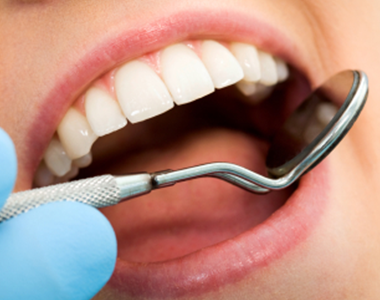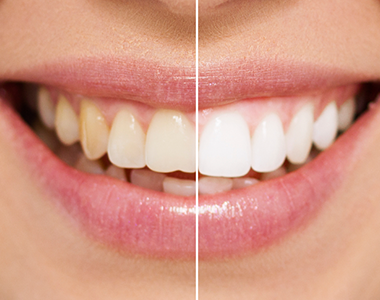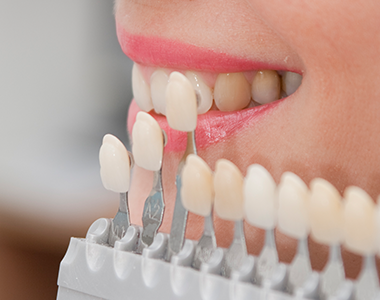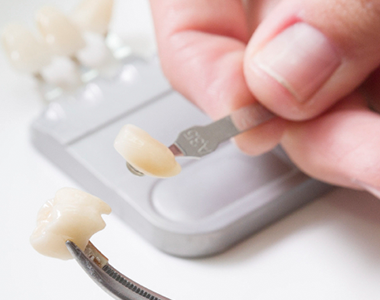At our office we focus on your overall oral health as well as the appearance of your teeth, mouth and smile. We provide complete restorative and cosmetic dentistry services to improve your health and help you maintain the appearance of your teeth for years to come. For a consultation, please contact us to book an appointment. We look forward to finding the best solutions that cater to your wants and needs.
Dental Hygiene
It is important to regularly brush and floss your teeth, as well as visit the dentist for routine checkups. Regular visits should occur every six months. In-depth cleanings are vital in preventing gum disease which can lead to oral health complications such as bleeding and swelling of gums, stained teeth, weak gums and a range of other dental problems. Our hygienists will scale, polish, take digital radiographs, provide dental sealants, treat periodontal disease, take impressions and provide instruction and education about how to properly care for your oral health.
Teeth Whitening
Over time teeth will stain from a variety of different foods and drinks, and it is difficult to avoid in our every day lives. Our highly-effective teeth whitening procedure will provide you with a long-lasting, bright smile. At our office the Zoom2 whitening system is used. During the whitening appointment the teeth are professionally polished. At least three applications of the strong whitening solution are applied with a high intensity blue spectrum light. To complete the whitening system, we make custom fitted bleaching trays to take home in order to maintain your bright new smile.
Porcelain Veneer Laminates
Porcelain veneers are a quick and simple solution to make your teeth more straight and white. With proper care they can last for years. The veneers are thin, semi-transparent porcelain “outer-shells” that are bonded to your teeth. Since they are constructed from porcelain, they are both highly functional and natural looking. We use them as a cosmetic treatment for problems such as broken or fractured teeth, gaps and spaces between teeth, crooked misshapen teeth, unsightly old fillings and yellow, stained teeth.During your appointment we will make impressions of your teeth in order to construct your veneers. They will be customized to match your teeth’s natural shade, restoring the aesthetic appearance of your smile. In the long run they will also help your teeth resist stains.
Dental Bonding
This is a common restorative treatment we use to hide unwanted defects and remove other imperfections. Purposes for the procedure include correcting a tooth gap, covering discolorations and repairing chipped/cracked teeth. The procedure takes approximately 30-60 minutes. A proper shade of resin is carefully chosen to match the rest of your teeth, which is then bonded to the teeth’s surface in successive layers. Our dentist sculpts the resin into the desired shape and it is then hardened with a high intensity light. A few final touches are applied and the teeth are polished to match the rest. The result is a very strong, natural looking restoration.
Composite Fillings
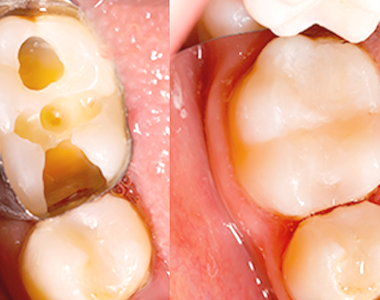
Composite fillings are now used in place of highly visible metal fillings to replace old fillings, straighten teeth, fill gaps between teeth, restore fractured and broken teeth, and repair discolorations. The composite-resin used is strong and long lasting, adhering directly to your teeth for high stability and durability. Composite fillings allow for more natural results and reduce the risk of tooth fractures due to the expansion and contraction characteristics of amalgam metal. The procedure requires minimal preparation, and can be completed in a single visit. Many dentists consider these types of fillings a healthier choice, as well.The dentist will first remove any remaining decay and then shape the final cavity in preparation. The composite-resin filling material will be added and cured (hardened). Finally, the dentist will polish the filling to adapt it smoothly to the natural shape of the tooth. Fillings do not last forever, and can deteriorate due to chewing, so it is essential that you visit the dentist regularly for routine checkups. We will examine the integrity of your fillings and recommend a replacement if necessary. Composite fillings will enhance the overall look of your smile.
Dental Bridges
Dental bridges are an excellent way to replace missing teeth. They offer superior stability to dentures and increase the quality of your bite. A dental bridge uses your neighboring teeth as support to fill in gaps left by missing teeth.The dentist will proceed by examining your mouth to ensure you’re a proper candidate. If suited, we will clean, shape and polish your adjacent teeth to fit the bridge in properly. The result will look natural and the bridge will match your teeth’s natural shade.
Dental bridges are semi-permanent, extremely comfortable, and allow you to chew and speak with confidence.
Dental Crowns
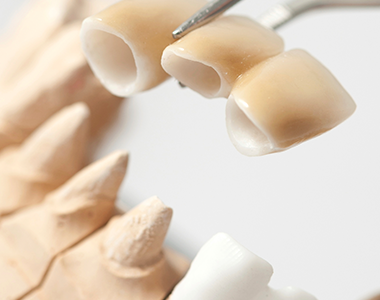
Dental crowns are used to treat a wide variety of dental problems, including repairing teeth that have been damaged, stained, decayed or chipped. They are often used to finalize root canal treatments, or fix a large filling. Dental crowns increase the strength of your teeth as they cover the entire tooth, all the way to the gum line. They are made of either dental composite or porcelain which are strong materials that will match the shade of your teeth. They are strong, long-lasting and help restore the original shape of a damaged tooth. As there are a variety of crowns available, our team will determine which type of crown is best suited for your particular need.The procedure will require two trips to our office, broken down as follows:
Appointment 1:
We will create impressions of your affected tooth using a specific mold. The mold will be used to make a temporary crown which will be sent to the laboratory for the production of the final crown. In order to properly replicate the original tooth without creating a replacement that is too large, the dentist will numb your tooth and reduce and reshape the surface. The temporary crown will be attached using adhesive material. A final check will be administered to ensure that the crown is a suitable fit and comfortable to wear.
Appointment 2:
We will remove the temporary crown and clean the recently prepared tooth. The new crown will be carefully fitted to ensure accuracy and comfort. You will receive care instructions and will be able to resume your daily activities immediately following the appointment.
Dental Implants
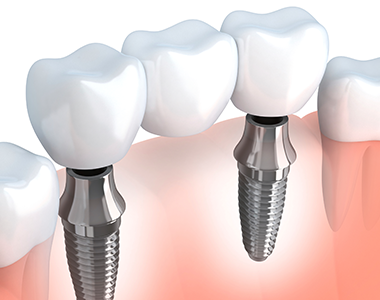
Missing teeth can make chewing, speaking and even smiling difficult tasks. Traditionally when teeth were missing the only options available were a fixed bridge placed in between the adjacent teeth, or a removable denture. Now dental implants are a great way to restore missing teeth in a permanent and easy to maintain manner. The replacement tooth is secured by a titanium anchor implanted directly into the jawbone, functioning like a natural tooth root by securing the tooth and your teeth’s positions. Though the surgery seems quite invasive, the bone has very little nerve endings. Patients tend to have less postoperative pain than they would from having a tooth taken out. In most cases people can go to work and continue with their normal lives the day after surgery.Dental implants can also be used to stabilize ill fitting or loose dentures by acting as an anchor. Patients tend to favour dental implants because they become a permanent part of your mouth and look and feel like natural teeth. Patients can confidently speak and chew without being concerned about their dentures shifting.
Certain dental insurance plans will partially reimburse patients for the implant procedures. We can advocate on your behalf with your dental insurance company to see if this coverage is available.
Full & Partial Dentures
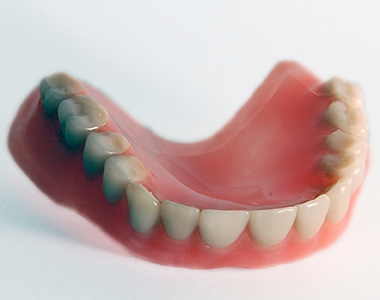
We offer both complete and partial dentures. Complete dentures are used to replace teeth in an entire arch when all teeth are missing, while partial dentures are used when some teeth are still present in that area. If you’ve lost several, or all of your teeth due to either cavities and decay, or an accident, we can restore your ability to eat and speak normally with dentures. Dentures can be made fixed or removable.Complete dentures are made with an acrylic base to imitate gum tissue. The base is made to closely fit the contours of the arch to ensure stability and comfort.
Partial dentures are made with a metal framework that has clasps that extend out and fit around existing teeth. The frameworks are designed to remain stable and allow for regular oral function such as chewing or speaking.
Your first appointment will involve trying on a wax model of the teeth to ensure that you are happy with the look of your final dentures. Also in certain instances, where a properly made denture is loose fitting, it can be stabilized with dental implants.
Invisalign
Invisalign is the brand name for a method of straightening your teeth without the use of metal braces. They are also easy to remove and more comfortable than traditional braces. They are ideal for older adolescents and adults as they are virtually undetectable. The technique utilizes a series of clear, removable aligners. Each set is worn for approximately two weeks and can be easily removed to eat, drink and brush your teeth. As each set is replaced, teeth gradually move until they are in the final prescribed position. We will meet with you every six weeks or so to ensure your treatment is progressing as planned. Like all new technologies there are some limitations. A consultation with us will determine if this is right for you.
Periodontal Therapy
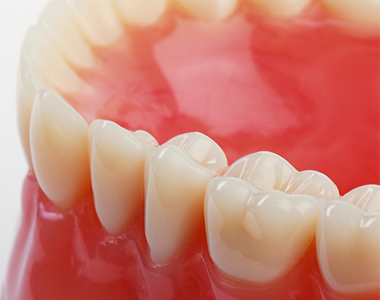
Periodontics is the area of dentistry that focuses on the health and functionality of the gums and sinuses. Periodontal disease attacks the gums and the bone that support the teeth. Keeping your gums healthy by brushing twice a day, flossing, and visiting the dental office every six months is important.
Gum disease has two main stages which are gingivitis and periodontal disease. Gingivitis is the earlier stage of gum disease and symptoms include swollen, tender or bleeding gums. Symptoms of periodontal disease include gum recession, deep gum pockets, loose teeth and tooth decay. If treated early enough, gum disease is reversible.
We recommend non-surgical gum therapy to treat gum disease in its early stages. The top three non-surgical gum disease treatments are local medication, curettage, and root-planning. Dr. Lee will examine you closely to determine which treatment plan is best for you.
Localized medication can be used once the area of bacteria and plaque accumulation below the gum line has been identified and cleared. The medication will either be an antibacterial rinse, or antibiotics placed directly below the gum line in the affected area.
Curettage may be chosen as treatment if the tissues around your tooth show signs of chronic irritation and inflammation. The process involves removing the infected gum tissue so that new, healthy gum tissue can grow.
If the gum disease is affecting the surface of your tooth’s root, then root-planning will be used for treatment. Root-planning involves removing and smoothing small amounts of the infected root surface to give your soft tissue a chance to heal from its disease.
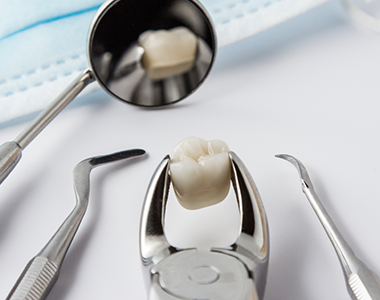
Teeth should be extracted when they are causing you pain and discomfort. Sometimes there is an infection causing the need for extraction, and it’s important to remove the tooth in order to prevent spreading to the nearby gums and teeth. Infections can spread even when you brush and floss regularly, so it is important to visit the dentist for preventative care. When oral infections are not treated in time, they may eventually cause your damaged tooth to fall out. Another problem is when a wisdom tooth has become impacted, which occurs when a wisdom tooth fails to erupt properly which can cause pain, swelling and discomfort. We will provide a proper assessment of the affected area to see if the tooth can be saved before proceeding.In some extreme cases, such as when the roots are damaged beyond repair, we may extract a tooth in preparation for a restorative procedure such as dentures or implants.
When it comes to wisdom teeth we carefully monitor them as they come in, checking for signs of swelling or impacting. Impacted teeth can crowd the teeth already in your jaw, pushing them forward and disrupting alignment. Wisdom teeth can also cause more serious health issues such as decay and the development of cysts. Wisdom teeth are removed to prevent future dental complications. It is typically recommended to have your wisdom teeth removed at a younger age before your teeth are completely grown in and attached to the jaw. However, there is no age limit on wisdom teeth removal.
Root Canal Therapy
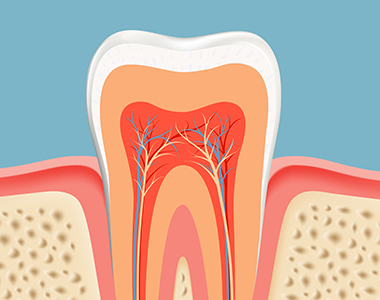
When you have a damaged or infected tooth we do everything we can to save it. One method to do this is through root canal therapy. This procedure can maintain the life of your teeth for many years, saving them from extraction.Each of your teeth is filled with dental pulp that extends down into the roots through thin canals. This pulp is very beneficial to your teeth, supplying oxygen through nerves and blood vessels, but it can become infected. This usually occurs when there is a large cavity in the tooth letting bacteria penetrate into the root canal. When this happens, your tooth can develop an abscess, which is very painful and can cause swelling. If left for too long, the abscessed tooth may lead to more serious oral health issues. Root canal therapy helps to prevent such infections.
During the procedure the dentist will access the pulp chamber in the crown to reveal the root canals. The infected nerve will be removed and the canals will be shaped using special files to smooth the walls and ensure no pulp tissue or infection is left. The canals are then filled with a special material that seals them off and protect the tooth’s chewing surface.


